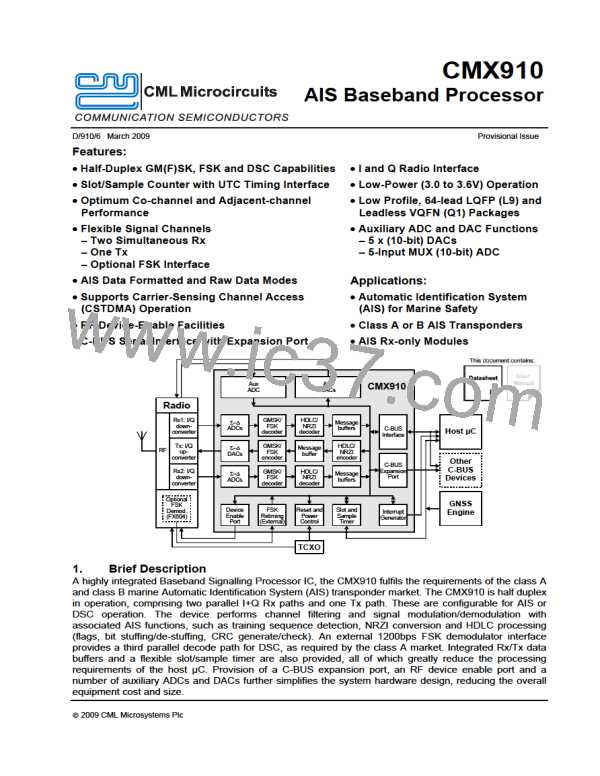AIS Baseband Processor
CMX910
6.
Supplementary Information
6.1
Glossary of Terms
Analogue-to-Digital Converter.
ADC
AIS
Automatic Identification System, an identification, location and communication system
using the maritime VHF radio band.
baud
The number of symbols transmitted per second in a modulated signal. Not necessarily the
same as bits per second.
bps
Bits Per Second, the speed at which bits are transmitted over a data channel.
Bandwidth-Time product, equal to filter –3dB bandwidth (B) × symbol time (T).
CML's serial communication interface for peripheral devices.
Cyclic Redundancy Check, a type of error detecting code.
BT
C-BUS
CRC
CSTDMA
DAC
DC
Carrier Sense TDMA, the channel access scheme used by AIS Class B.
Digital-to-Analogue Converter
Direct Current, often used to refer to the static or unchanging part of a signal.
Digital Selective Calling, an early maritime communication system.
DSC
FIFO
First In First Out, a queue-based data buffer where data is output in the same order as it
arrives. Also known as an “elastic buffer”.
FSK
Frequency Shift Keying, a modulation scheme in which data symbols are represented by
a shift in output signal frequency.
GALILEO
GFSK
A satellite navigation system developed by the European Union.
Gaussian Frequency Shift Keying, an FSK modulation scheme with a Gaussian filtered
output signal.
GLONASS
GMSK
GNSS
Global Orbiting Navigation Satellite System, a satellite navigation system developed by
the Commonwealth of Independent States (former Soviet republics).
Gaussian Minimum Shift Keying, an FSK modulation scheme with a modulation index of
0.5 and a Gaussian filtered output signal.
Global Navigation Satellite System, a generic term for the GPS, GLONASS and GALILEO
satellite navigation systems.
GPS
Global Positioning System, a satellite navigation system developed by the U.S.
Department of Defense.
HDLC
High-level Data Link Control, a synchronous data link protocol adopted by the ITU for use
in AIS.
IC
Integrated Circuit.
IMO
ITU
International Maritime Organisation.
International Telecommunication Union, an organisation established to standardise and
regulate international radio and and telecommunications.
µC
Microcontroller
NRZ
Non Return to Zero, a binary data coding scheme where 1s and 0s are represented by
distinct signal levels.
NRZI
Non Return to Zero Inverted, a binary data coding scheme where 1s cause no change in
a transmitted signal level, and 0s cause a change (this is NRZI “change on 0” as used in
AIS, as opposed to NRZI “change on 1”).
PA
Power Amplifier.
PER
PRBS
Packet Error Rate.
Pseudo-Random Bit Sequence, an apparently random stream of bits typically generated
by a linear-feedback shift register.
© 2009 CML Microsystems Plc
52
D/910/6

 CMLMICRO [ CML MICROCIRCUITS ]
CMLMICRO [ CML MICROCIRCUITS ]